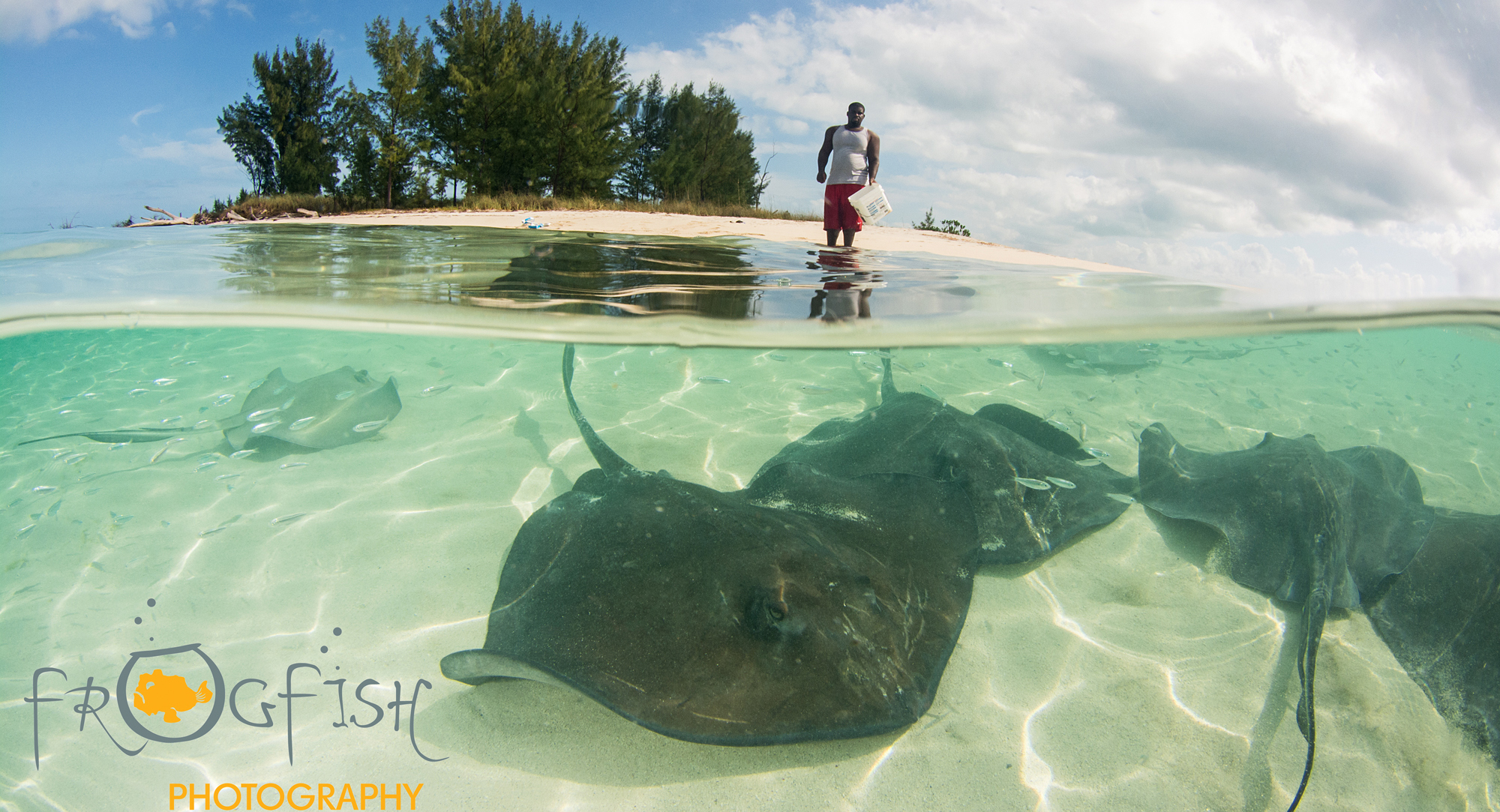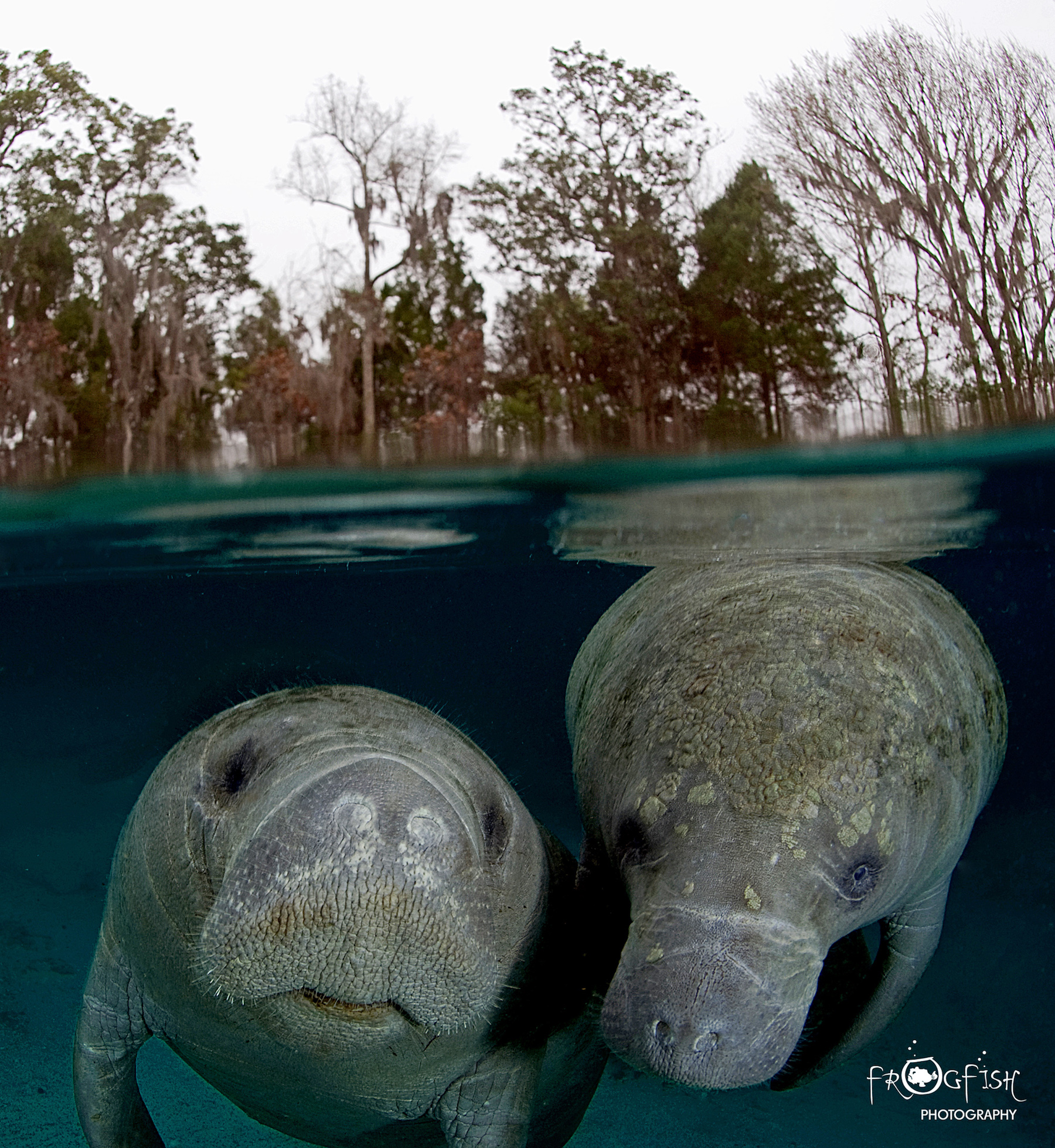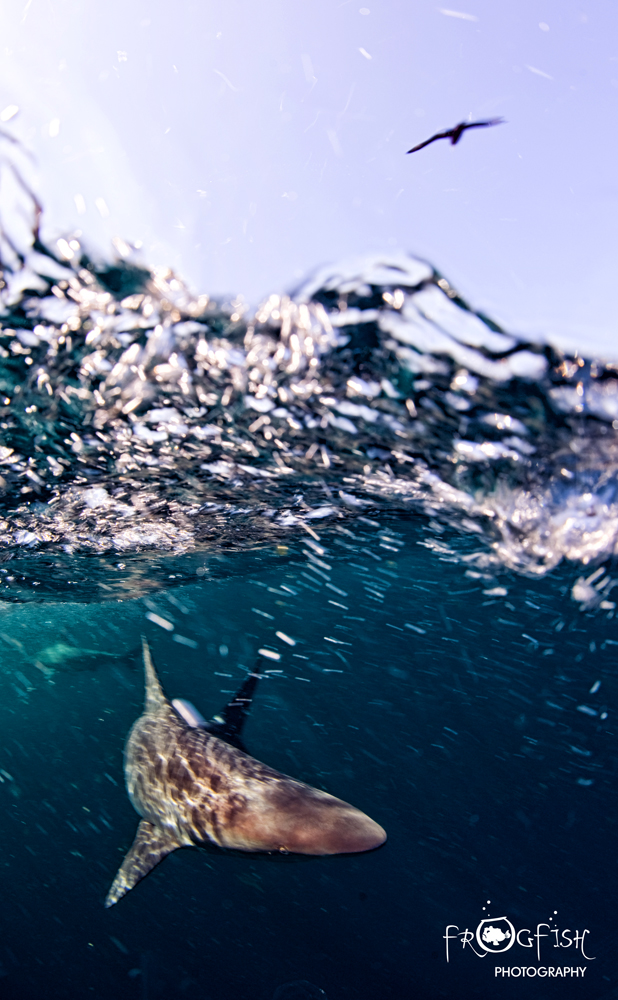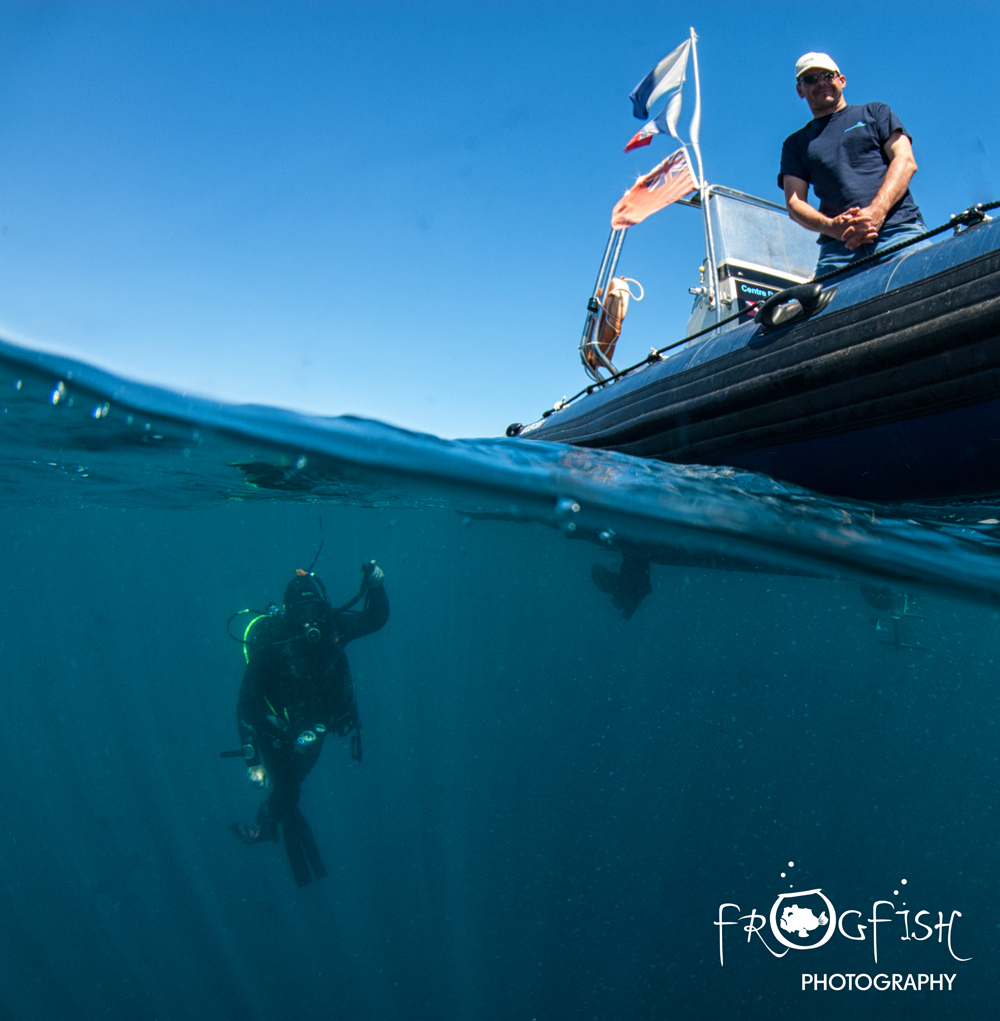News
Photo Gallery: Split-Shots

The second feature in our new Gallery series where we let the photos tell the story… This week, Nick and Caroline focus on photo technique with split-shots.
Split-shots or over-under shots are where some of the image is above the water and some below. It is a great technique most commonly done with a wide angle or fish-eye lens in a large dome port. To attempt these shots, it is best to wait for very calm water, to help you get a smooth transitional line from above to below. If you are shooting in the shallows on a sunny day, then you may not need to use strobes, but as the top half will be brighter, it is sometimes vital to have the strobes lighting your underwater subject. When you get the shot right, these can really enhance your portfolio of images.
Tips: Use as large a depth of field as you can (small aperture of say f16); try to move your camera gently so as not to create any bubbles around the port; dunk and shoot before the water starts to run down the dome and creates smears (you can even use spit to help improve this technique). For more from Nick and Caroline, visit www.frogfishphotography.com

Image 1: Swimming Pig in The Bahamas
These wonderful swimming pigs in The Exumas in The Bahamas make the perfect split-shot subjects. The water is clear and calm and it is almost always sunny and the pigs swim around in shallow water. A perfect place to try this sort of shot, especially as they always swim with their snouts sticking out of the water like snorkels. Tokina 10-17 lens, f/13, 1/125, ISO 100. No strobe used.

Image 2: Manatee Pair in Crystal River, Florida
This is another perfect destination and subject for the split shot. These gorgeous creatures love to swim up to you and will get in close enough to fill the frame. The location is lovely too with trees growing around this fresh water spring. Alas, we did not get nice sunny weather, that would have made this shot so much more appealing. Nikon 16mm lens, f/9, 1/80 ISO 400.

Image 3: Paddy Swimming
Paddy (or any other co-operative water loving dog) makes a perfect subject when you want to practice this technique! He loves to swim and can be called in (or tempted with a ball) to get close to the camera. The sea conditions were not perfect, with some swell and waves, but we love this shot capturing just his eye out of the water as he swam along the stone jetty at Trefor Pier in Wales. Tokina 10-17mm lens, f/13, 1/400, ISO 320.

Image 4: Blacktip Shark & Bird
It is not often that you can get a shot of a shark swimming and a bird flying in the same shot! There is plenty that could be improved, but the opportunity was a fleeting one and the shot grabbed. This was taken at Aliwal Shoal in South Africa, where it is rare to get calm seas and split shots were the last thing on our minds. But it is a shot we love for that very reason. It is harder to hold the camera in the portrait orientation for split shots, but well worth practicing for these moments. Nikon 16mm lens, f/10, 1/160, ISO 200.

Image 5: Lemon Sharks in The Bahamas
This was taken lying on the platform on the back of the boat and dangling the camera in the water! There was quite a big swell and so it was hard to time when to hit the shutter button. The sharks stayed with us as we came up from an excellent dive and this was an opportunity we had to grab for the captain said we needed to head home. Tokina 10-17mm lens, f/18, 1/200, ISO 500.

Image 6: Caroline Surfacing in France
A great way to capture the start of end of the dive is to get a split shot of the boat (and in this case boat captain) with a diver below. This shot was taken whilst diving in France on an epic road trip and shows Caroline just about to finish the dive. Nikon 16mm lens, f/11, 1/125, ISO 250.

Image 7: Cuban Crocodile
A split shot does not have to be 50% above the water and 50% below. Experiment with how much you want to feature from under the water and at what angle. This shot if a very close-up portrait of a crocodile taken in Jardines de la Reina in Cuba. We wanted it to show both the underwater seagrass habitat as well as a little of the mangroves in the background. Tokina 10-17mm lens, f/16, 1/60, ISO 250.

Image 8: Stingrays in The Bahamas
This shot was one we planned before getting into the water, with our guide standing on a deserted small idyllic island and stingrays in the shallows. The clam water and the ability to keep the glass dome dry before taking this shot all helped, as did the sunshine. Tokina 10-17mm lens, f/20, 1/200, ISO 400.
You can now get wide angle and fish eye lenses and domes for almost every underwater camera, from a GoPro to a top end SLR, so go out and try getting a split shot. They are very rewarding when they work out, but they do take a bit of practice! Why not let us know how you get on?
Gear News
Introducing the TR-80, IR-50 and CS-30 Regulators from DYNAMICNORD

Whether you are a beginner or a professional diver – with the three new main regulators from DYNAMICNORD, everyone will find their favourite regulator. They all look super stylish.
Excellent performance with the TR-80
Quality and performance are the be-all and end-all for regulators. It is not for nothing that the TR stands for Tec Reg. The innovative design of the TR-80 guarantees absolute reliability – even in ice-cold waters.

Perfect breathing effort at 0.8 J/l / certified for diving in waters below 10 degrees / structural design made of solid brass for best cold protection / membrane-compensated design with dry seal of the first stage / reduced exhalation effort thanks to optimized exhalation membrane and bubble deflector / adjustable Venturi (dive/predive) and adjustment knob for individual inhalation comfort / innovative design of the front cover prevents free-flow in strong currents or when diving with scooters / design made of sandblasted brass, matt chrome finish / 2 HP and 4 LP outlets / mouthpiece made of high-quality, anti-allergic silicone for maximum comfort.


Amazing underwater adventures with the IR-50
The IR-50 is the top regulator for advanced and experienced divers. Natural breathing is the essence of this regulator.

Ideal breathing effort at 0.8 J/l /certified for diving in waters below 10 degrees / compensated membrane / adjustable venturi (dive/predive) and adjustment knob for individual inhalation comfort/ outlet valve and deflector for minimum exhalation effort and reduction of bubbles on the face / design made of sandblasted brass, matt chrome finish / 2 HP and 4 NP outlets / mouthpiece made of high-quality, anti-allergic silicone for maximum comfort.


The Workhorse – our CS-30
For diving centres and diving beginners – the workhorse stands for strong construction, reliability and robustness. Perfect for your training.

Optimal breathing effort at 0.8 J/l /recommended for diving in waters above 10 degrees / non-compensated piston / adjustable venturi (dive/predive) / outlet valve and deflector for minimum exhalation effort and reduction of bubbles on the face / design made of sandblasted brass, matt chrome finish / 1 HP and 3 NP outlets / mouthpiece made of high-quality, anti-allergic silicone for maximum comfort.


Octopus OP-30
The OP-30 is the ideal addition to all DYNAMICNORD regulators. It is identical in construction to the CS-30.

The TR-80, IR-50, CS-30 (DIN & INT) regulators and the Octopus OP-30 are available from DYNAMICNORD dealers and in the online store.
DYNAMICNORD – Your Outdoor Companion.
Marine Life & Conservation
Paul Watson Released as Denmark Blocks Japan’s Extradition Bid

Renowned anti-whaling activist Paul Watson has been released from custody in Greenland after spending five months in detention. Denmark’s Justice Ministry rejected Japan’s request for his extradition, citing insufficient guarantees that his time already served in custody would be credited against any potential sentence.
The 74-year-old Canadian-American was arrested on July 21 in Nuuk, Greenland’s capital, when his ship docked to refuel. His arrest was based on a 2012 Japanese warrant related to a 2010 encounter in Antarctic waters. Japan alleged Watson obstructed operations and caused damage to a whaling research ship during efforts to disrupt illegal whaling. Watson has consistently denied these claims, maintaining his commitment to marine conservation.
Denmark, which oversees extradition matters for Greenland, concluded that while the legal conditions for extradition were met, the lack of assurances from Japan regarding time-served credit made extradition untenable.
In a video shared by his foundation, Watson expressed gratitude and relief, saying, “After five months, it’s good to be out… and good to know they’re not sending me to Japan.” He added that the most difficult part of his time in custody was being separated from his two young sons.
Watson is a pioneering figure in marine conservation, known for founding the Captain Paul Watson Foundation in 2022 after decades of activism with the Sea Shepherd Conservation Society. His bold efforts to defend marine life have earned him widespread support, including from celebrities and conservationists. His work has also been featured in the acclaimed reality TV series Whale Wars.
Watson’s lawyer, Jonas Christoffersen, praised the decision, stating, “We are happy and relieved that Paul Watson is now free.” He added that Watson is eager to reunite with his family and continue his vital work.
The arrest occurred while Watson’s vessel, the M/Y John Paul DeJoria, was en route to the North Pacific with a team of 26 volunteers to intercept a Japanese whaling ship. His foundation described the arrest as politically motivated and emphasized that Watson’s actions were focused on ending illegal whaling practices.
Japan resumed commercial whaling in 2019 after leaving the International Whaling Commission, asserting that whale meat is a cultural tradition. Conservationists, however, continue to challenge these practices, highlighting their impact on marine ecosystems.
Despite the challenges, Watson remains steadfast in his mission to protect marine life and bring attention to whaling practices. His dedication to ocean conservation has made him a globally respected advocate for the environment.
-

 News2 months ago
News2 months agoIconic SS United States to become the World’s Largest Artificial Reef
-

 News3 months ago
News3 months agoBook Review – 52 Assignments: Underwater Photography
-

 Gear News3 months ago
Gear News3 months agoDYNAMICNORD – New German diving brand enters the British market
-

 News3 months ago
News3 months agoExploring Cenote El Pit: A Diver’s Dream
-

 Gear News3 months ago
Gear News3 months agoTry BARE drysuits (and maybe even win one!) this Friday with Sea & Sea at North West Dive Fest
-

 Marine Life & Conservation3 months ago
Marine Life & Conservation3 months agoBook Review: Coral Triangle Cameos
-

 Blogs2 months ago
Blogs2 months agoDive the Egyptian Red Sea this Autumn with Regaldive
-

 News3 months ago
News3 months ago2024 Ocean Art Underwater Photo Competition Announced















